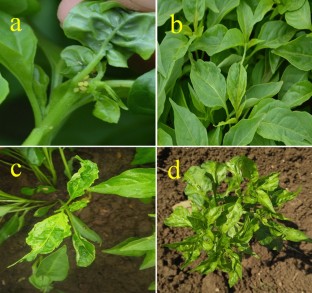Validation for the prevalence of virus complex and identification of virus resistance lines among the genotypes of chilli (Capsicum annuum L.)
Megharaj Kaginalli Chandrashekarappa, Ajjappalavara Prabhudeva Shantappa, Patil Hanamathagouda Bheemagouda, Abdul Kareem Mohammad, Ratnakar Shet, Raghavendra Satyanarayana, Hegde Gopalkrishna, Manjunathagowda Dalasanuru Chandregowda, Ajjappalavara Prabhudeva Shantappa, Patil Hanamathagouda Bheemagouda
Research Articles | Published: 16 June, 2021
First Page: 684
Last Page: 691
Views: 3693
Keywords: Chilli, Chilli Veinal Mottle Virus , Chilli Leaf Curl Virus , Resistance
Abstract
The molecular identification of different viruses was done, because identification of viral disease based on phenotypic symptoms is difficult and complicated. The molecular detection results revealed that the incidence of Chilli Veinal Mottle Virus during kharif crop was predominant, whereas the chilli virus samples collected from late kharif (August–September), rabi (October–November) and summer (March–April) crop resulted in predominance incidence of Chilli Leaf Curl Virus (ChiLCV) among the samples. Whereas the Chilli Leaf Curl Virus (ChiLCV) and Chilli Veinal Mottle Virus in early kharif (May) crop favours the virus complex in chilli. Furthermore, by phenotyping of genotypes for virus disease in the field and genotyping with molecular markers linked to chilli virus resistance, virus-resistant genotypes were identified namely DCA-295, DCA-107, DCA-154, DCA-222, DCA-224 and DCA-232. They were recorded to have least viral disease incidence, which reveals their resistance against studied chilli viruses, and therefore these genotypes were considered as field resistant to the chilli virus disease.

References
- Abu-Kassim AB (1986) Virus diseases of horticultural crops in Malaysia. In: FFTC book series. Food and Fertilizer Technology Center for the Asian and Pacific Region, Taipei, p 193
- Appiah AS, Quartey EK, Amoatey HM, Nunekpeku W, Owusu-Ansah M, Ofori S (2014) Response of nine cultivars of pepper (Capsicum spp.) to infection by four viruses under natural field conditions in the coastal savanna zone of Ghana. Res J App Sci Eng Technol 7(5):903–907
- Aramburu J, Galipienso L, Lopez C (2007) Reappearance of Cucumber mosaic virus isolates belonging to subgroup IB in tomato plants in North-eastern Spain. J Phytopathol 155:513–518
- Banerjee A, Dutta R, Roy S, Ngachan SV (2012) First report of Chilli veinal mottle virus (ChiVMV) in Naga chilli (Capsicum chinense) in Meghalaya, India. Virus Dis 25(1):142–143
- Bhute NK, Bhosle BB, Bhede BV, More DG (2012) Population dynamics of major sucking pests of Bt cotton. Indian J Entomol 74(3):246–252
- Butani DK (1976) Pests and diseases of chilli and their control. Pesticides 10:38–41
- Chattopadhyay B, Singh AK, Yadav T, Fauquat CM, Sarin NB, Chakraborty S (2008) Infectivity of the cloned components of a begomovirus: DNA beta complex causing chilli leaf curl disease in India. Arch Virol 153:533–539
- Dennis BB, Narceo BB (2007) Molecular detection of whitefly-transmissible geminiviruses (Family Geminiviridae, Genus Begomovirus) in the Philippines. Philipp J Sci 136(2):87–101
- Duffus JE (1971) Role of weeds in the incidence of virus diseases. Ann Rev Phytopathol 9:319–340
- El-gaied LF, Salama MI, Salem AM, Amani FN, El-deen, Naglaa A, Abdallah (2008) Molecular and serological studies on a plant virus affecting strawberry. Arab J Biotechnol 11:303–314
- Green SK, Kim JS (1994) Sources of resistance to viruses of pepper (Capsicum spp.): a catalog. Asian Vegetable Research and Development Center, Taipei, p 64
- Hidayat SH, Opriana E, Manzila I, Sujiprihati S (2012) Occurrence of Chilli veinal mottle virus (ChiVMV) in Indonesia and response of chilli germplasms to ChiVMV infection. J ISSAAS 18(2):55–61
- Kareem MA, Byadgi AS (2016) Cloning and characterization of coat protein gene from CVMV. J Pure Appl Microbiol 10(1):317–321
- Khan MS, Raj SK, Singh R (2006) First report of Tomato leaf curl New Delhi virus infecting chilli in India. Plant Pathol 55(2):289
- Kumar S, Dubey AK, Karmakar R, Kukkundoor K, Mathew R, Mathew K, Prakasha HS (2012) Inhibition of TMV multiplication by siRNA constructs against TOM1 and TOM3 genes of Capsicum annuum. J Virol Metods 186(1–2):78–85
- Kumar S, Rai M (2005) Chile in India. Chile Pepper Inst Newslett XXII:1–3
- Ong CA, Varghes G, Pho TW (1979) Aetiological investigations on a veinal mottle virus of chilli (Capsicum annuum L.), newly recorded from peninsular Malaysia. Malays Agric Res Dev Inst Res Bull 7:78–88
- Ong CA, Varghes G, Pho TW (1980) The effect of Chilli veinal mottle virus on yield of chilli (Capsicum annuum L.). Malays Agric Res Dev Inst Res Bull 8:74–79
- Ravi KS, Joseph J, Nagaraju N, Krishna PS, Reddy HR, Savithri HS (1997) Characterization of a pepper vein banding virus from chilli pepper in India. Plant Dis 81:673–676
- Reddy MK, Sadhashiva AT, Reddy KM, Chalam C, Deshpande AA, Chandro A (2001) Integrated disease and pest management: leaf curl and other viruses of tomato and peppers. In: Proceedings of the final workshop, Bangkok, Thailand, pp 3–8
- Reddy MK, Srivastava A, Kumar S, Kumar R, Chawda N, Ebert AW, Vishwakarma M (2014) Chilli (Capsicum annuum L.) breeding in India: an overview. Sabrao J Breed Genet 46(2):160–173
- Roopa M, Ashok KCT (2014) Seasonal incidence of pests of capsicum in Bangalore conditions of Karnataka, India. GJBAHS 3(3):203–207
- Sambrook J, Russell DW (2001) Molecular cloning: a laboratory manual, pp 17–32
- Shah H, Yasmin T, Fahim M, Hameed S, Haque MI (2009) Prevalence, occurrence and distribution of Chilli veinal mottle virus in Pakistan. Pak J Bot 41(2):955–965
- Sherwood JL, Reddick BB, Conway KE (1986) Reaction of Bahamian hot pepper to single and double infection with Tobacco Mosaic Virus (TMV) and Potato Virus Y (PVY). Plant Dis 72:14–16
- Solangi GR, Moghal SM, Khanzada SD (1983) Identification of some viruses infecting Solananeous hosts in Sindh. Pak J Bot 15(1):19–24
- Stephan R, Gracy CP, Kavya VH (2016) Temporal shift of Byadgi chilli area in the Dharwad and Haveri districts of Karnataka and finding out the reasons. IJSMMRD 6(1):41–46
- Manjunatha L (2008) Studies on bud blight disease of tomato caused by Groundnut bud necrosis virus. University of Agricultural Sciences, Dharwad, Karnataka, India Dissertation: M.Sc. Thesis
Author Information
College of Horticulture, University of Horticultural Sciences, Bagalkot, India